On February 5 I climbed Newman Peak, the highpoint of the Picacho Mountains north of Tucson and one of the 73 Arizona peaks with at least 2000 feet of prominence. Newman Peak has a reputation for difficult access and brushy and rocky slopes so I did my homework beforehand and drove in to below the peak the previous afternoon and camped for the night so as to be ready for an early start hiking the next morning.
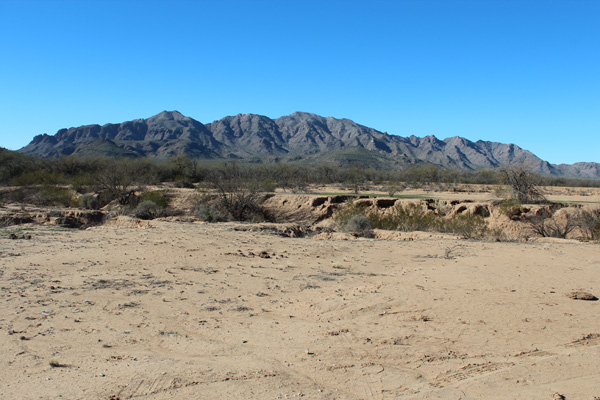
I drove to near Newman Peak from the south on primitive roads, crossing the Central Arizona Project Canal in two places. I researched the driving route from online reports, USGS topo maps, and satellite images and carried these notes with me, updating them as I worked my way in. As I passed through the first of three gates I entered Arizona State Trust Land and I was prepared with my annual recreation permit.
Here are my driving notes:
- Take Exit 219 off I-10.
- 0.0 mi – Zero your odometer at the Frontage Road on the east side. Turn right and head south.
- 5.0 mi – Turn Left onto paved Park Link Drive and cross two railroad tracks.
- 5.8 mi – Turn Left onto paved Pecan Road. Head north on good pavement.
- 10.8 mi – Continue Straight onto a primitive dirt road as the pavement continues right on Harmon Road.
- 10.9 mi – Turn Left onto another primitive dirt road.
- 11.6 mi – Pass through a gate onto State Trust Land (permit required). Immediately Turn Right and drop into a broad wash.
- 11.9 mi – Climb out of the wash and immediately Turn Right.
- 12.2 mi – pass through a second gate as you cross over the buried CAP Canal.
- 12.3 mi – Turn Right, then cross a short wash.
- 12.5 mi – Cross a cattle guard.
- 12.6 mi – Bear Right towards a bridge over the CAP Canal.
- 12.7 mi – Cross the bridge and Bear Slightly (not hard) Right.
- 12.8 mi – Turn Left at a fork.
- 13.2 mi – Pass camp sites.
- 13.3 mi – Continue Straight at a junction (not right).
- 13.4 mi – Turn Right at a T junction and follow along a fence.
- 14.4 mi – Turn Right at a T junction and pass through a wire gate.
- 15.3 mi – I camped at 2190 ft elevation.
- 15.5 mi – Pass the fenced game water facility (do not camp within 1/4 mile).
The road soon drops down into a wash and gets rougher. - 15.9 mi – Turn Right at a junction.
- 16.4 mi – Road ends.
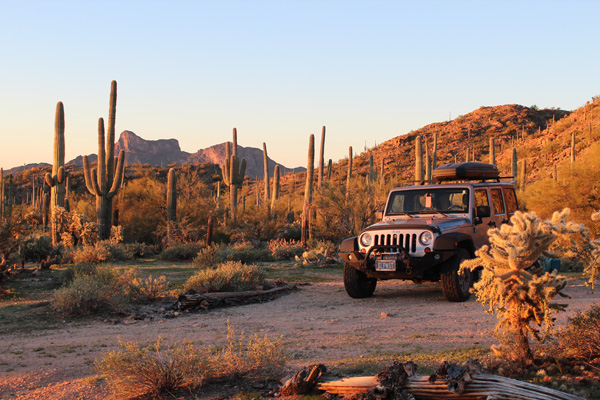
I camped in a nice opening amongst saguaro, cholla, and prickly pear cactus just off the road about a quarter mile before a fenced game water facility. I set my tent up beside the Jeep and enjoyed dinner in my camp chair with a celebratory Black Butte Porter and Rampant IPA. The evening and night at camp was quiet with only the occasional sound of a nearby saguaro skeleton rattling in the breeze.
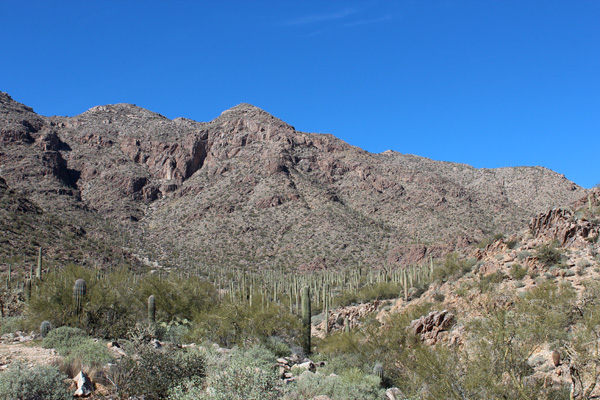
The next morning I followed the road to its end. Beyond the road I traveled cross country around brush and cactus, over a few washes, and traversed up and to the right across slopes to reach a deep gully leading steeply upwards between rocky ridges. My eventual route, the ESE Ridge, descends left to right below the right skyline in the above photo.
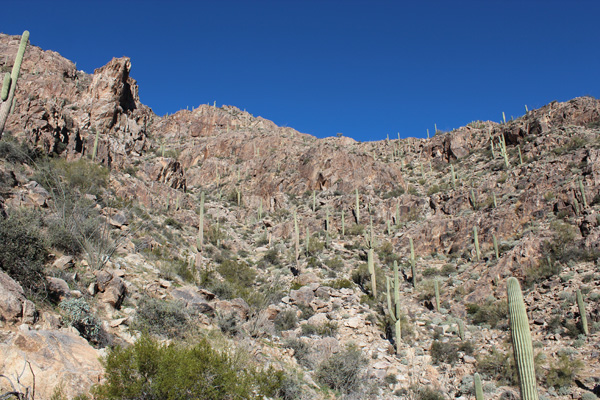
I pondered the route to take upwards. The ridge to the left seemed too steep for my interest. I considered descending into the wash and then climbing up over rock bands directly towards the ridge line on the right in the above photo but thought one of the rock bands might be problematic. Instead, I decided to cross the wash and traverse right to reach the far ridge before ascending.
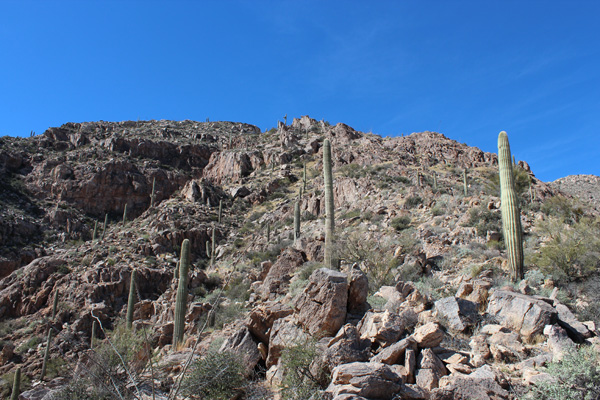
I called this ridge the ESE Ridge, between the Southeast Ridge to the left and the East Ridge to the right described in earlier reports. This rocky ridge had mostly firm footing and was fun to climb with occasional class 3 rock. Near the top of the ridge I traversed over talus and through brush below a cliff to reach the easier summit ridge visible on the far right in the above photo.
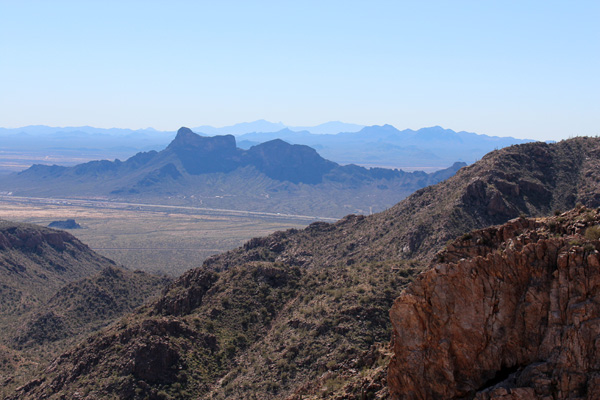
I began to get good views of other peaks as I climbed the ESE Ridge. In the photo above Picacho Peak is the shady, cliffy peak just beyond I-10. Beyond it to the right are the Silver Bell Mountains and in the distance is Coyote Mountain and Kitt Peak. The tower of Baboquivari Peak is just visible in the far distance between Coyote Mountain and Kitt Peak.
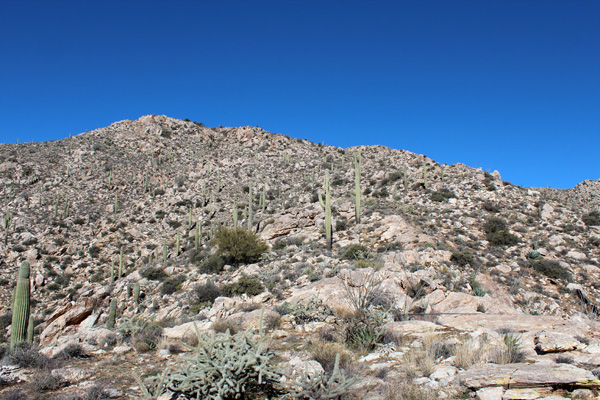
The summit ridge was a fun walk. The summit with its communication towers is just out of view beyond the ridge line above to the left in the above photo.
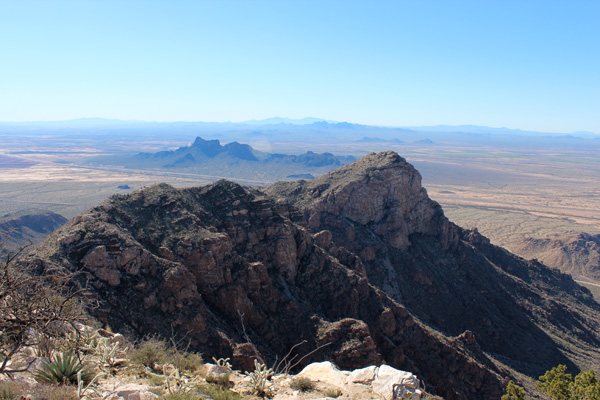
It was a nice day for climbing. The route was challenging enough and fun and I enjoyed identifying many surrounding ranges and peaks from the summit. My next goal is to revisit Coyote Mountain to hopefully summit. Next fall I hope to visit Baboquivari Peak before snow and ice complicate climbing its tower.
I descended the same route to my car, always thankful when I arrived to see the tires were still inflated and the engine started without trouble. After a pleasant rest I retraced the drive out with the help of my Jeep navigation system.

Leave a Reply